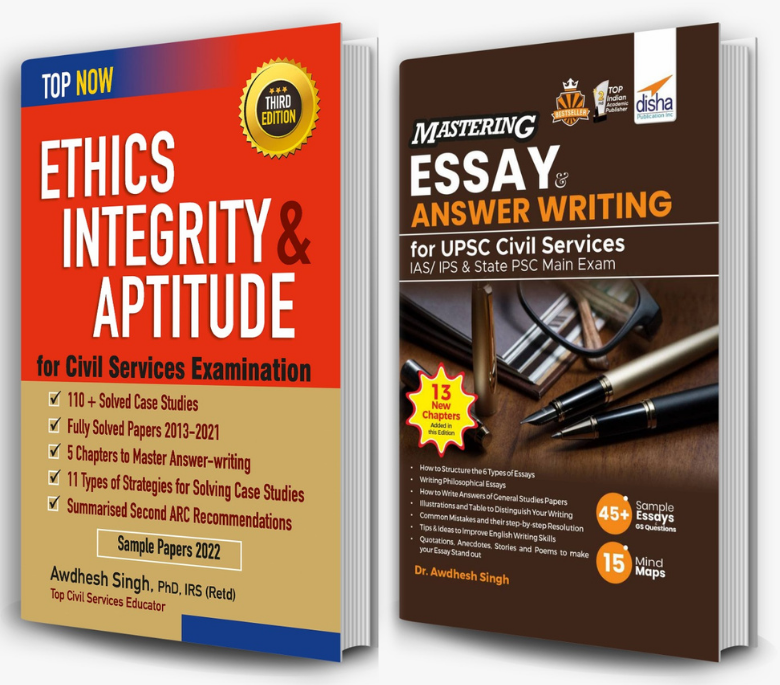Essay and Answer Writing → Model Essays
Topics
All
Civil Services in India (26)
Ethics, Integrity and Aptitude
» Chapters from Book (11)
» Case Studies (8)
Solved Ethics Papers
» CSE - 2013 (18)
» CSE - 2014 (19)
» CSE - 2015 (17)
» CSE - 2016 (18)
» CSE - 2017 (19)
» CSE - 2018 (19)
» CSE - 2019 (19)
» CSE - 2020 (19)
» CSE - 2021 (19)
» CSE -2022 (17)
» CSE-2023 (17)
Essay and Answer Writing
» Quotes (34)
» Moral Stories (18)
» Anecdotes (11)
» Beautiful Poems (10)
» Chapters from Book (5)
» UPSC Essays (40)
» Model Essays (38)
» Research and Studies (4)
Economics (NCERT) Notes
» Class IX (14)
» Class X (16)
» Class XI (55)
» Class XII (53)
Economics Current (51)
International Affairs (20)
Polity and Governance (61)
Misc (77)
Select Topic »

Civil Services in India (26)
Ethics, Integrity and Aptitude (-)
» Chapters from Book (11)
» Case Studies (8)
Solved Ethics Papers (-)
» CSE - 2013 (18)
» CSE - 2014 (19)
» CSE - 2015 (17)
» CSE - 2016 (18)
» CSE - 2017 (19)
» CSE - 2018 (19)
» CSE - 2019 (19)
» CSE - 2020 (19)
» CSE - 2021 (19)
» CSE -2022 (17)
» CSE-2023 (17)
Essay and Answer Writing (-)
» Quotes (34)
» Moral Stories (18)
» Anecdotes (11)
» Beautiful Poems (10)
» Chapters from Book (5)
» UPSC Essays (40)
» Model Essays (38)
» Research and Studies (4)
Economics (NCERT) Notes (-)
» Class IX (14)
» Class X (16)
» Class XI (55)
» Class XII (53)
Economics Current (51)
International Affairs (20)
Polity and Governance (61)
Misc (77)

Covid-19 and the BioMedical Waste crisis
According to a Central Pollution Control Board (CPCB) report, India generates about 101 Metric Tonnes per day (MT/day) of Covid-19 related bio-medical waste. Of this, Maharashtra accounts for over 17% of India’s bio-medical waste. Covid-19 has presented us with many unique challenges, un-estimated amounts of BMW generation being one of them. Generation of unregulated BMW ends up in landfills, posing health risks for its pickers, sanitation workers, etc. Amidst the coronavirus disease pandemic, the scenario has worsened as evidenced by some initial experiences, with piles of personal protective equipment (PPE) accumulating in the hospitals and quarantine centres. The essay focuses on the issues related to Bio Medical Waste management, the challenges and some possible solutions.
What is BMW?
Biomedical waste is defined as any waste, which is generated during the diagnosis, treatment or immunisation of human beings or animals, or in research activities pertaining to, or in the production or testing of ‘biologicals’. It may also include waste associated with the generation of biomedical waste that visually appears to be of medical or laboratory origin as well research laboratory waste containing biomolecules or organisms that are mainly restricted from environmental release.
Biomedical waste may be solid or liquid. Examples of infectious waste include discarded blood, sharps, unwanted microbiological cultures and stocks, identifiable body parts, human or animal tissue, used bandages and dressings, discarded gloves, other medical supplies that may have been in contact with blood and body fluids, and laboratory waste that exhibits these characteristics. Biomedical waste is also generated from biological and medical sources and activities, such as the diagnosis, prevention, or treatment of diseases.
Biomedical waste must be properly managed and disposed of to protect the environment, general public and workers, especially healthcare and sanitation workers who are at risk of exposure to biomedical waste as an occupational hazard. The development and implementation of a national waste management policy can improve biomedical waste management in health facilities in a country.
Steps in the management of biomedical waste include:
·Generation
·Accumulation
·Handling
·Storage
·Treatment
·Transport
·Disposal
The issues related to irresponsible management of BMW
Proper biomedical waste management in accordance to the stipulated rule has been one of the neglected aspects of health care for years, especially in developing countries like India. BMW Management Rules, 2016 by Government of India, Ministry of Environment, Forest, and Climate Change initiated changes by prescribing simplified categories (colour coded) for segregation of different BMWs, an amendment in 2018 also came into force with the aim to improve the compliance to the rules. Nonetheless, proper segregation, handling, and disposal remain a serious concern for health care facilities across India with an annual growth rate of 7% with a projected estimate up to 775.5 tonnes/d by the year 2022.
The outbreak of Coronavirus has not only exposed the poor healthcare infrastructure and lack of preparedness to battle a pandemic but also some loopholes in the waste management process in the country. According to a report filed by the Central Pollution Control Board (CPCB) in the National Green Tribunal in July, India generates about 101 Metric Tonnes per day (MT/day) of Covid-19 related bio-medical waste. This quantity is in addition to the regular bio-medical waste generation of about 609 MT per day. The report clearly states that the available capacity for incineration of Covid-19 biomedical waste in the country is about 840 MT against the total generation of about 710 MT per day.
Some pressing issues related to dealing with BMW are:
·Limited capacity for waste disposal – BMW is taken either to a common treatment facility or waste-to-energy plant for waste disposal. India has announced 200 CBWTF which are running on a 60% capacity.
·The ‘incinerators’ have not been upgraded to handle the covid situation.
·Lack of tracking the collected waste
Steps taken: possible solutions
India needs to take up challenges in bio-medical management on a war footing. The pandemic did not break the system instead it only helped in revealing a broken system. Three crucial steps in this regard are:
·Defining the Covid waste
·Identifying different types of waste generators
·Launching a large scale campaign for education and awareness related to PPE usage for both healthcare and non-healthcare sectors.
As per the Guidelines for Quarantine Facility COVID-19 issued by the Ministry of Housing and Urban Affairs, waste is to be bifurcated in four streams:
·Eye protection goggles, recyclable materials like pens, plastic water bottles and bed sheets are to be kept in red bins. The collected waste is to be disinfected through autoclave or microwave and sent for recycling.
·Sharp waste including metals is to be discarded in white bins. For the treatment, sterilisation is to be followed by shredding or containers mutilation or encapsulation.
·Glassware, tube light, CFL bulbs, LED used in quarantine facility are to be kept separately in a cardboard box marked blue. The waste is to be disinfected and sent for recycling.
·Used personal protective equipment (PPE), gloves, shoe covers, head covers, disposable bed sheets, and PPE with spill is to be discarded in a yellow bin and incinerated or buried in deep pits.
Although the CPCB is the nodal agency for making any recommendation pertaining to BMW in India, some guidelines have also been published by other government agencies for the management of Covid waste. While the latter guidelines must conform to the recommendations made by CPCB, disparities have been noted in some with respect to the segregation norms of existing BMW Management Rules, 2016 in which the segregation of the items is devised based on the final mode of treatment. This abrupt change in the category of certain BMWs might result in inappropriate final treatment.
As is evident from the current situation of the pandemic, basic infection control practices are the only measures for containment. Proper waste disposal is an integral part of these control measures. There is a need for a thorough implementation of the prescribed policies with the scope of overall improvement in the BMW segregation and disposal in daily practice which will be of immense help even after the pandemic.
Conclusion
Biomedical waste is a threat to global public environmental health. Worldwide, it is estimated that at least 5.2 million people, including 4 million children, die each year because of diseases related to unmanaged medical waste. Considering the transmission of severe cases of Covid-19 globally, excessive biomedical waste has become a new major threat to public health and the environment. Improper handling of hospital waste might aggravate the crisis to medical staff and people who handle waste. In order to deal with the unprecedented situation, the Indian government has taken a number steps to ensure proper handling and disposal of BMW. The aim is to establish a comprehensive regime for bio-waste management.
(Sources: Wikipedia.com / ncbi.nlm.nih.gov / ndtv.com)

Looking for a One-stop Solution to prepare for ‘Ethics, Integrity, and Aptitude’ and ‘Essay and Answer Writing’ for UPSC?
Buy Dr. Awdhesh Singh’s books from the links below-
Ethics, Integrity & Aptitude for Civil Services Examination
Amazon - https://amzn.to/3s1Qz7v
Flipkart - https://bit.ly/358N2uY
Mastering Essay & Answer Writing for UPSC Civil Services
Amazon - https://amzn.to/3JELE2h
Flipkart - https://bit.ly/3gVIwmv
| Related Articles |
| Recent Articles |
